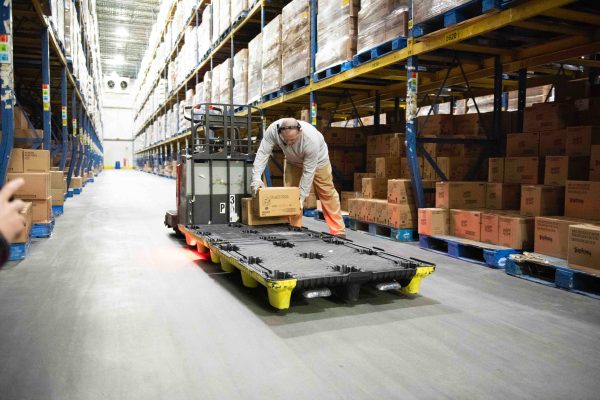When it comes to warehouse safety, training is a key piece in building the foundation.
That line of thinking was echoed by several businesses and organizations interviewed by Material Handling Wholesaler this month, as those in the industry work to ensure safe warehouse spaces.
At TrainMOR, which offers forklift training in any class of truck as well as a scissor and boom lift training program, options to train in person and online are both in use, according to Russ Niedzwiecki, the corporate safety trainer. “About four years ago, we began to produce our own online training program. We basically matched it to the live program,” said Niedzwiecki, of TrainMOR, whose parent company is Morrison Industrial Equipment.
The timing of the online training development proved advantageous. “We happened to have our program just started before COVID started,” said Niedzwiecki, who said throughout the waxing and waning pandemic, the online training progressed into a natural component of the business. Niedzwiecki added that TrainMOR is now doing lots of live training again but the expectation is that the use of online training will continue. “The popularity of (online training) right now may be at the ground level, but we feel the ground is rumbling,” he said.
 Niedzwiecki said training can be done on a regular basis, noting TrainMOR offers a library of safety short videos to help keep information fresh as well a unique program that includes sharing a small poker chip with customers containing a QR code that can be scanned daily to access pieces from the video library. “It’s fresh training right in their hands,” he said. “Safety administrators can use it from their desk.”
Niedzwiecki said training can be done on a regular basis, noting TrainMOR offers a library of safety short videos to help keep information fresh as well a unique program that includes sharing a small poker chip with customers containing a QR code that can be scanned daily to access pieces from the video library. “It’s fresh training right in their hands,” he said. “Safety administrators can use it from their desk.”
TrainMOR’s approach is to take on a consultant role for each customer in determining specific needs, according to Niedzwiecki. “Imagine someone being in front of a forklift. Where do you think the biggest expense is on this truck? The biggest expense is in the seat. We want to make sure that even though there are lots of advances, it still boils down to the operator being trained,” he said.
Safety events
Brian Feehan, president of the Industrial Truck Association, agreed. “We know that operator training is a critical component” of warehouse safety, he said. “First, it’s a requirement from OSHA. Second, we know that it works. You can never tell that message too many times.”
ITA will host its annual National Forklift Safety Day on June 14, 2022, with an emphasis on the importance of the need for operator training. “In today’s environment, where you’ve got labor shortages everywhere, there may be a lot of people relatively new to the industry,” said Feehan, who said Forklift Safety Day serves as an opportunity for a national round table on forklift training that can work in conjunction with events on the local level. “We provide our members and subsequently their sub-groups information on how to conduct their own events,” said Feehan, who said although local events marking the forklift safety day mostly ground to a halt during 2020 and 2021, the hope is they will be reinstated this year.
ITA’s online events for safety day over the past two years drew a large attendance, so this year both in-person and online components will be included, according to Feehan.
Another focus of the event will be on the increase of automated vehicles in the warehouse and how to effectively train employees to operate them safely. “We embrace that technology, but there’s training required,” Feehan said.
National Forklift Safety Day also offers an opportunity for industry members to focus on a shared objective. “It’s an excellent opportunity for the industry at large to support safety,” Feehan said. “With safety, everybody puts on the same hat.”
At Raymond, the emphasis on training is also key. “Training is our number one priority,” said Dave Norton, vice president of customer solutions and support. He said online training is helping complement hands-on training, noting that more people can start with baseline training and can continue watching a truck’s progression through a warehouse.

Raymond is able to train operators on real-life trucks or through simulations. Norton envisions training options continuing to evolve with the workforce, especially as the pace of hiring and retention changes. “We’re always working with customers investigating and helping how they can improve operator training,” he said, adding that he believes operator assist technology will continue to evolve.
OSHA will also host its Safe + Sound week from Aug. 15 to 21. The nationwide event recognizes the successes of workplace health and safety programs and offers information and ideas on how to keep America’s workers safe, the website said.
Safety products
In addition to training procedures, products are also being developed to enhance warehouse safety. At Raymond, a Pick2Pallet™ LED Light system helps operators identify pallet placement correctly, with an aim of enhancing efficiency and productivity, according to Norton.
Telematics in the Raymond iWAREHOUSE™ allows for monitoring operator behavior. The technology also includes a daily checklist for product operation.
“It’s randomized so they can’t just click ‘yes’ all the way through. It will make them read the question and answer appropriately,” Norton said. The data also allows Raymond customers to coach and work with operators, Norton added.
The company offers products like a truck system that communicates with the warehouse system to direct an operator to the next pick phase. “So, they don’t have to figure out where in the aisle the pick location is,” Norton said. “You can also incorporate that system with end-of-aisle stops.”
At Wildeck, Inc. a variety of products help ensure safety, according to Cory Thomas, products manager of guarding products. Wildeck is a subsidiary of Holden Industries and is a U.S. manufacturer of industrial steel work platforms, vertical lifts, rideable material lifts, safety guarding products, industrial ladders, crossovers, and more, according to the website.
“Wildeck has three different levels of protection,” said Thomas in describing the company’s guard rail gate systems, noting an LT line, an MT Medium Duty line, and an XT Heavy Duty line. The heavy-duty XT line offers a 13,000-pound impact rating at 4 miles per hour, the MT is 10,000 pounds and the LT is like a visual barrier.
Wildeck also offers dock safety gates, which Thomas said are helpful for companies as the weather warms and some opt to leave gates open. “We’re still in the middle of the big change,” he said, noting changes from old systems of painting or taping safety guides on the floor to implementing newer tech. “I think people are still in the middle of the big shift to get actual guardrail protection up,” Thomas said.
Noting the large increase in requests for Wildeck safety products in recent years, Thomas said he envisions demand will remain strong as people change warehouse layouts and updates are installed. “There’s always going to be a market for this and it definitely is going to continue to grow,” he said, noting that safety budgets have been increasing and that as e-commerce and larger warehouses grow, the need will expand. “It’s a super important aspect of every company that is becoming more of a focus point,” Thomas said.










